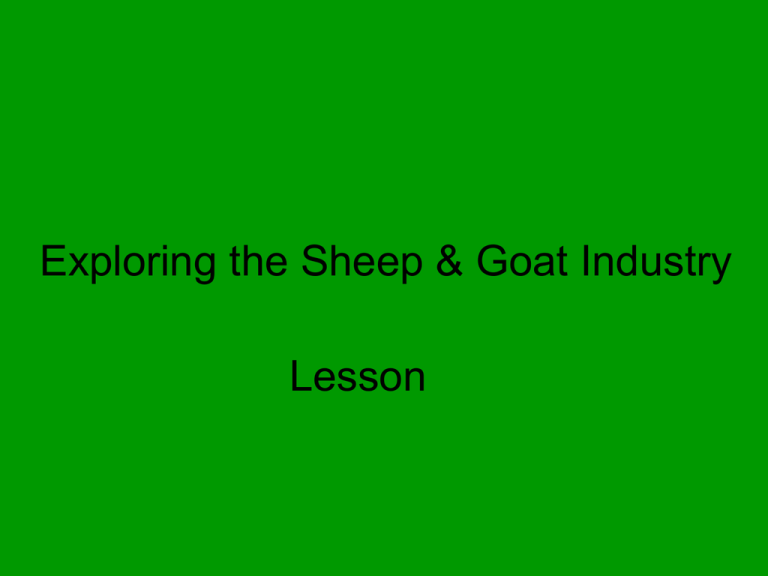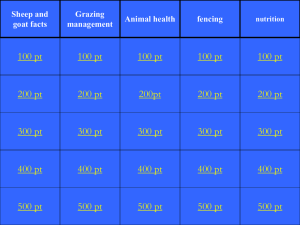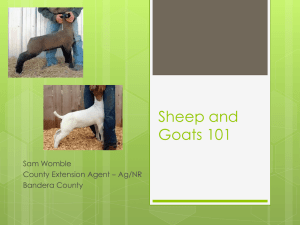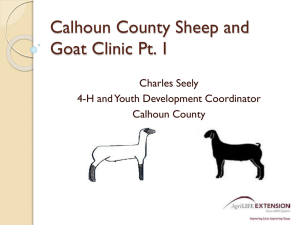
Exploring the Sheep & Goat Industry
Lesson
Interest Approach
• Ask the students to come up with as
many products as possible that are
made with sheep and goats.
• Write the examples on the board.
• Encourage students to come up with
meat, milk, chammy, clothing, and
other items.
Student Learning Objectives
• Discuss terminology associated with
sheep and goat production.
• Describe sheep and goats as organisms
and compare them externally.
• Identify common breeds of sheep and
goats.
• Explain methods of producing sheep
and goats.
• List favorable and unfavorable factors.
Terms
•
•
•
•
•
•
•
•
Buck
Cashmere
Chammy
Confinement
Doe
Ewe
Kid
Kidding
•
•
•
•
•
•
•
•
Lamb
Lambing
Mohair
Mutton
Ram
Wether
Wool
Yearling
Discuss terminology associated with
sheep and goat production.
Objective #1
What are some specific terms used to
describe sheep and goat production?
• Doe - female goat or sheep.
• Buck - male goat at any age.
• Kid - goat of either sex under 1 year of
age.
• Yearling - goat of either sex over one
year, but under 2 years of age.
• Wether - male goat or sheep that has
been castrated when young.
• Ram - male sheep used for breeding
purposes.
What are some specific terms used to
describe sheep and goat production?
• Ewe - a female sheep.
• Kidding - process of a goat giving
birth.
• Lambing - process of a sheep giving
birth.
• Lamb
–sheep under one year old.
–meat from a young sheep.
What are some specific terms used to
describe sheep and goat production?
• Mutton - meat from a sheep that is
over one year of age.
• Chammy - leather made from sheep
and goats.
• Wool - a sheep’s coat that is used
as a fiber for products such as
clothing.
Describe the sheep and goats as
organisms and compare them
externally.
Objective #2
What are some comparisons between
sheep and goats?
Terms
• Mohair
– Hair taken from angora goats and used to
make a wooly fabric.
Sheep & Goat Similarities
•
•
•
•
•
Mammals.
Ruminant digestive systems.
Have divided hoofs.
Raised for food and clothing.
Important to economy.
What are some comparisons
between sheep and goats?
•
•
•
•
Sheep
Very efficient
converters of feed to
meat.
Prefer broadleaf
plants & grasses.
Weigh between 100
to 225 pounds at
maturity.
Live from 7 to 13
years.
•
•
•
•
•
Goats
Low importance to
economy.
Prefer to eat twigs &
leaves.
Weigh between 20
and 150 pounds.
Live 8 – 10 years.
Produce 60% of
mohair.
External Parts of a Goat
External Parts of a Sheep
Identify common breeds of sheep
and goats
Objective #3
What are common breeds of sheep
and goats?
• Over 200 breeds of sheep.
• Over 300 breeds of goats.
• Breed selection is based on
personal needs and goals.
• Animals should come from
reputable producers and be free of
diseases.
Suffolk
• Most popular sheep
breed.
• Medium wool breed.
• Originated in
England.
• Large bodied.
• Head, legs, ears are
black.
• Polled.
• 8 – 10 lbs. fleece.
• 150% lamb crop.
United Suffolk Sheep Association
PO Box 256 -17 West Main
Newton, UT 84327
Phone 435-563-6105
Continental Dorset
Club PO Box 506,
North Scituate, RI
(401) 647-4676
Dorset
• Originated in
England.
• Medium-wool breed.
• Polled or horned.
• Completely white.
• Medium sized body.
• 7 – 8 lbs. fleece.
• Ewes breed out of
season for fall lambs.
• Muscular carcasses.
• Good milk producers.
Hampshire
• Originated in
England.
• Large sheep.
• Polled.
• Black faces, noses,
ears, and legs.
• Early maturing.
• Good milkers.
• 7 – 8 lbs. fleece.
American Hampshire Sheep Association,
1557 173rd Ave.
Milo,IA 50166
Phone: (515) 942-6402
American Oxford Sheep Association
1960 E 2100 North Road
Stonington, Ill 62567
Oxford
• Originated in
England.
• Medium-wool breed.
• Very large breed.
• Polled.
• Face, ears, & legs
gray to brown.
• 10 – 12 lbs. fleece.
• Lambs grow quickly.
• Used in
crossbreeding.
Angora
American Angora Goat Breeders
PO Box 195
Rocksprings, TX 78880
• Originated in Turkey.
• Well adapted to areas not
fit for others.
• Almost totally white at
maturity.
• Produce 7 lbs. mohair.
• Horned.
• Long droopy ears.
• Buck weigh 125 – 175 lbs.
• Does weigh 80 – 90 lbs.
Dairy Goats
LaMancha
Saanen
• Produce 5 lbs. of
milk daily.
• More minerals than
cow’s milk.
• Easier to digest.
• Dairy breeds
– French Alpine
– LaMancha
– Nubian
– Saanen
– Toggenburg
Meat Goats
• Known as Spanish
goats.
• Produce both milk
and meat.
• Sometimes called
brush goats.
• Largest meat goat
population in
Texas.
Cashmere Goats
• Developed by selective breeding.
• Cashmere
–Soft undercoat of fine down produced
by goats.
• Large demand for cashmere.
• Solid colored goats are preferred in
cashmere production.
Pygmy
National Pygmy Goat Association,
166 Blackstone St
Mendon, MA 01756
• Originally exported
from Africa.
• Only 16 to 23 inches
tall at withers.
• Horned.
• Any color or
combination.
• Research, pets, 4-H
and FFA projects,
zoos.
Explain methods of producing
sheep and goats.
Objective #4
How do you produce sheep and
goats?
• Farm Flock
– Can have 1 to
1,000 animals.
– Located in
midwestern,
eastern and
southern U.S.
– Purpose are to
produce market
lambs and wool.
• Purebred Flock
– Sells rams and ewes
of an ideal type.
– High management
requirements.
– Knowledge of
genetics.
– 4-H & FFA members
get their first animals
from these
producers.
How do you produce sheep and goats?
• Range band method • Confinement Method
– Large bands of sheep
between 1,000 and
1,500 being managed
over a large area by a
herder.
– High vegetation area
animals are used for
meat.
– Low vegetation
animals are used for
wool.
– Confinement - raising
animals completely
indoors.
– Less land.
– Fewer parasite
problems.
– Ability to monitor
animals.
– Increased building
costs.
– Higher feed costs.
– Intense management.
How do you produce sheep and
goats?
• Lamb feeding production.
–Involves weaning lambs and selling
them to feedlots where the lambs are
fed out to slaughter weight.
List favorable and unfavorable
production factors.
Objective #5
What are some favorable and unfavorable
production factors you may want to consider
before starting a sheep or goat business?
• Price for wool changes often.
• Consumption of lamb & mutton are
not as common.
• Cotton & other material are used
frequently and that decreases the
demand for wool.
• Predators can kill sheep.
• Return on investment is usually fast.
What are some favorable and unfavorable
production factors you may want to consider
before starting a sheep or goat business?
• Sheep more susceptible to parasites
and are less resistant to diseases.
• Castrating & other health needs can be
difficult.
• Difficult to find knowledgeable help.
• Easily raised on rough terrain with little
feed.
• Dual income for meat & wool.
• Animals are easy to handle by young
people.
Review
• What are some specific terms used to
describe sheep and goat production?
• What are some comparisons between sheep
and goats?
• What are common breeds of sheep and
goats?
• How do you produce sheep and goats?
• What are some favorable and unfavorable
production factors you may want to consider
some facts before starting a sheep or goat
business?









